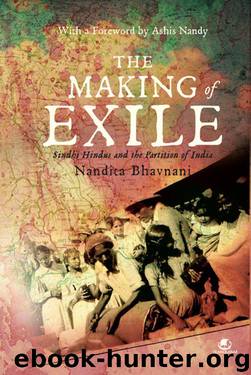THE MAKING OF EXILE: SINDHI HINDUS AND THE PARTITION OF INDIA by NANDITA BHAVNANI

Author:NANDITA BHAVNANI [BHAVNANI, NANDITA]
Language: eng
Format: epub
Publisher: Tranquebar
Published: 2014-07-28T18:30:00+00:00
CHAPTER 10
A New Geography
Bombay
Bombay, the city as well as the province (which then also included portions of present-day Gujarat and Karnataka) was the preferred destination for many Sindhi Hindus, for it was relatively easy to access, being a few days’ journey away by sea. Moreover, unlike trains, sea voyages were relatively safe from attack. Passage by steamer also enabled the migrants to carry more luggage with them.
Bombay was also of deep psychological significance for Sindhi Hindus. During the colonial period, Sindh had been part of the Bombay Presidency for close to a century, and Sindhis felt a strong connection with the city. Several Sindhi Hindu businessmen also had office branches in Bombay city, and often had relatives settled there who could be relied upon for accommodation. Moreover, since Sindhi colleges were still affiliated to Bombay University, the educational transfer of Sindhi students was comparatively easier in the province.
For those who had neither family nor friends in Bombay, this city of opportunity had its own allure. Bombay was a port and a commercial city, a modern metropolis comparable with Karachi. Many Karachi-ites identified with the urbane atmosphere of Bombay; they could not imagine living in other, smaller Indian towns. Even those businessmen who did not have a branch office in Bombay had faith in the city’s business prospects; professionals believed that their chances of employment were far greater in Bombay than elsewhere. Finally, several people chose the metropolis simply because their relatives and friends had chosen to migrate there, creating a multiplier effect. Many Sindhis living in South Bombay recall congregating at Marine Drive in the evenings where, in an era when telephones were not ubiquitous, they could catch up on each other’s news and meet those who had recently arrived from Sindh.
Kishu Mansukhani was a 10-year-old boy when Partition became a reality. His father had arranged to send all the children and other members of the extended family to Bombay. Kishu Mansukhani recalls:
I clearly remember that we travelled in a ship named Ekma.
There were about 25 of us who landed in Mumbai. But where do we go from here? For a few days we stayed at my father’s Gujarati friend’s place. As I was young and the surroundings were new to me, I was quite enjoying myself as I had never seen trains without engines or double-decker buses.
With the help of these good Samaritans and my father’s influence, we managed to get an apartment. It was about 1,200 square feet, where all 25 of us used to stay. It had just one hall, one bedroom and one bathroom and on top of it all the apartment was on the fifth floor. All were family members, uncles, aunts, cousins, etc. All of them were quite young. We had come with our uncle Karamyogi Gangaram, while my parents stayed back in Sindh as they wanted to wind up everything and sell our properties etc.
[…] There were about four to five beds in the house, which were called khatu or charpai. The elders would sleep on the bed and the children would sleep under the bed.
Download
This site does not store any files on its server. We only index and link to content provided by other sites. Please contact the content providers to delete copyright contents if any and email us, we'll remove relevant links or contents immediately.
| Africa | Americas |
| Arctic & Antarctica | Asia |
| Australia & Oceania | Europe |
| Middle East | Russia |
| United States | World |
| Ancient Civilizations | Military |
| Historical Study & Educational Resources |
The Sympathizer by Viet Thanh Nguyen(4280)
The Rape of Nanking by Iris Chang(4119)
World without end by Ken Follett(3409)
Ants Among Elephants by Sujatha Gidla(3383)
Blood and Sand by Alex Von Tunzelmann(3113)
Japanese Design by Patricia J. Graham(3088)
City of Djinns: a year in Delhi by William Dalrymple(2493)
The Queen of Nothing by Holly Black(2457)
Foreign Devils on the Silk Road: The Search for the Lost Treasures of Central Asia by Peter Hopkirk(2418)
India's Ancient Past by R.S. Sharma(2388)
Inglorious Empire by Shashi Tharoor(2383)
Tokyo by Rob Goss(2361)
In Order to Live: A North Korean Girl's Journey to Freedom by Yeonmi Park(2325)
Tokyo Geek's Guide: Manga, Anime, Gaming, Cosplay, Toys, Idols & More - The Ultimate Guide to Japan's Otaku Culture by Simone Gianni(2301)
India's biggest cover-up by Dhar Anuj(2296)
The Great Game: On Secret Service in High Asia by Peter Hopkirk(2281)
Goodbye Madame Butterfly(2187)
Batik by Rudolf Smend(2086)
Living Silence in Burma by Christina Fink(2022)
